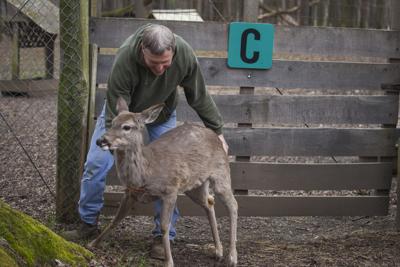Even deer can have varying personalities.
Some are very docile, others are inquisitive and some are skittish, according to Anthony Musselman.
Musselman, a student worker at the Penn State Deer Research Center, was describing the unique personalities of the 75 white-tailed deer that are part of the center’s herd.
The Penn State Deer Research Center was constructed in 1972 with the purpose of offering deer research opportunities for faculty and students. The 22-acre enclosure is home to a herd of captive white-tailed deer, individual holding pens, a feed room, chutes for deer restraint and an animal scale.
Don Wagner worked at the facility for four years when he studied wildlife and fisheries science at Penn State. After graduating and working as a lab technician in one of the animal science labs on campus, his extensive experience allowed him to take over when the former caretaker retired. Wagner has managed the facility for the past 19 years.
The Deer Research Center provides exceptional opportunities to students by allowing them to gain hands-on experience in animal husbandry and research. As the only full-time worker, Wagner oversees the students who fill the various roles at the facility.
“It gives them the opportunity to actually experience the work,” Wagner said. “It really helps them in their job search because they can say they did more than just learn about these topics in classrooms, but they actually were able to take part in them and experience them firsthand.”
Experience at the facility benefits students in a wide range of areas, from natural resource management to veterinary sciences. Many students go on to work with state game or wildlife agencies or attend vet school. The spectrum of research opportunities helps to prepare students in a broad range of fields.
“We’ve done a lot of projects over the years ranging from general nutrition to chemical repellants to working with the USDA on fertility control.” Wagner said. “Most recently we’ve done palpability studies to determine types of vegetation that deer prefer to eat. Now, we’re working with fencing designs to prevent contact between captive deer herds and wild deer herds to reduce transmission of disease.”
Maddy Schneider’s time at the Deer Research Center has helped her prepare for a career in veterinary medicine. The application process for veterinary school is extremely competitive, but Schneider was successful in receiving admission and is currently deciding between two different vet schools.

Tony Musselman (senior-Wildlife and Fisheries Science) plays with a deer at Penn State Deer Research Center on Wednesday, Apr. 17th, 2019.
“I believe that having this particular opportunity, because it is so unique, really helped me stand out during the application and interview process.” Schneider (senior-veterinary and biomedical sciences) said. “I am not sure whether or not I want to study wildlife medicine in vet school, but none the less, I am certain that the experiences that I gained from working here will stick with me throughout the rest of my career.”
Joey Dell first heard of the Deer Research Center from a friend who worked there. Upon touring the facility, knew it was the perfect job for him.
Students that work at the facility are responsible for daily animal husbandry tasks to ensure the deer are healthy and taken care of. On top of that, they take part in the various research projects that take place, such as the current fencing project to reduce disease transmission between wild and captive deer herds.
“Employers appreciate hands-on experience.” Dell (senior-wildlife and fisheries science) said. “The fact that I have chemical immobilization experience and experience around large animals that are essentially still wild, it reflects well on a resume in addition to that classroom experience because I was able to take those class concepts and apply them in real life.”
Currently, there are 75 deer in the white tail herd. Students that work at the facility have the opportunity to get to know these deer due to their daily tasks of caring for the herd.
“I’ve always really liked animals, and over the course of the time I’ve worked here, I’ve gotten to know the deer well,” Dell said. “As crazy as it sounds, I’m pretty sure they all have their own personalities. You get used to going in everyday and feeding them and making sure their healthy, so you really feel like you have a part in raising them and doing something every day for these animals.”

Joey Dell, left, (Senior-Wildlife and Fisheries Science) and Robert McGarry (junior-Wildlife and Fisheries Science) play with a deer at Penn State Deer Research Center on Wednesday, Apr. 17th, 2019.
Musselman is another student worker who has spent the last two years interacting directly with the deer herd. He too has formed a bond with the animals and enjoys seeing each deer’s unique characteristics.
“My favorite part about working at the facility is the individual personalities of deer and that there is always something new to do,” Musselman (senior-wildlife and fisheries science) “White tails hardly exhibit sexual dimorphism and so they often look the same. When you are able to work with these animals, they often present individual personalities that remain unique within the herd.”
With new topics and issues presenting themselves at the forefront of deer research, the opportunities will continue to rise and vary. A hot topic that’s currently being examined is Chronic Wasting Disease (CWD), a contagious neurological disease that infects deer and is fatal for the animals. CWD has been rapidly spreading to various states, including Pennsylvania. The fencing initiative is related to CWD by reducing possibility of disease transmission.
“When I say there is always something new to do, I am referring to the ever-changing tasks each day brings.” Musselman said. “One day you might be repairing a fence in a paddock, the next you may be artificially inseminating deer. It never gets boring at the facility.”








